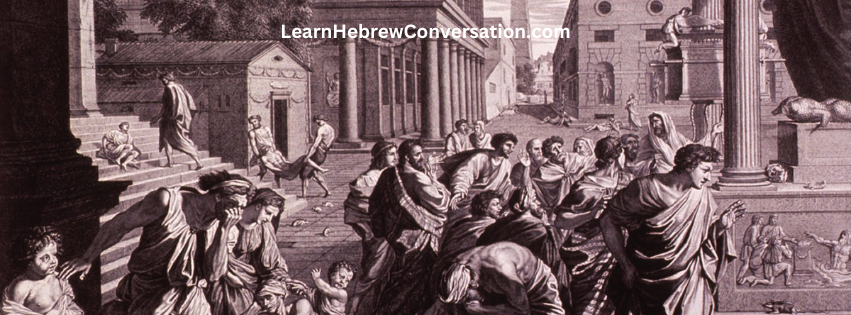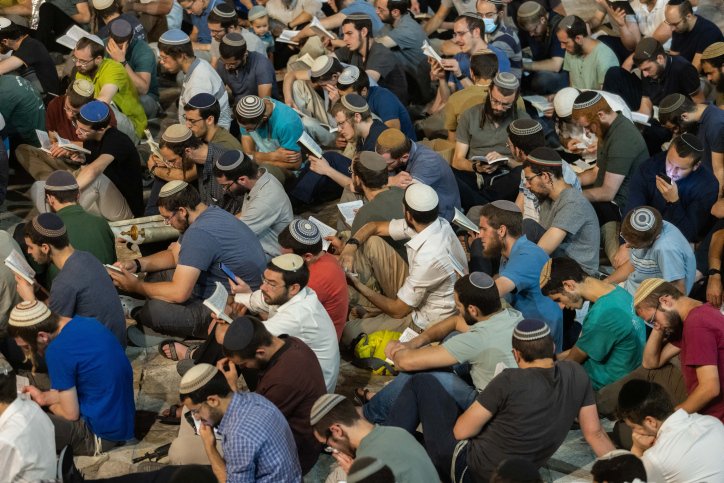Tisha B Av, observed on the ninth day of the Hebrew month of Av, is a day of deep mourning in the Jewish calendar. This day marks a series of catastrophic events in Jewish history, primarily the destruction of the First and Second Temples in Jerusalem. It is observed mostly through fasting and mourning rituals.

Origins of Tisha B’Av
The origins of Tisha B’Av date back to biblical times. According to tradition, several tragic events occurred on this day, including:
- The report of the spies in 1313 BCE: The Israelites, upon hearing the negative report from the spies sent to scout the Promised Land, despaired and refused to enter it. As a result, God decreed that the generation would wander in the desert for 40 years.
- Destruction of the First Temple: In 586 BCE, the First Temple, built by King Solomon, was destroyed by the Babylonians, leading to the exile of the Jewish people.
- Destruction of the Second Temple: In 70 CE, the Second Temple was destroyed by the Romans, marking a significant turning point in Jewish history and leading to a prolonged period of suffering and diaspora.
- Other tragedies: Over the centuries, other calamities also occurred on or near this date, including the defeat of the Bar Kochba revolt, the expulsion of Jews from England in 1290, and from Spain in 1492.
Customs and Observances
Tisha B’Av is marked by a 25-hour fast and several mourning practices, reflecting the depth of the tragedies remembered on this day.
Fasting and Restrictions
The fast begins at sunset on the eve of the 9th of Av and concludes at nightfall the following day. Boys from the age of 13 and girls from the age of 12 (Gil Mitzvot) are required to fast. During this period, the following activities are prohibited:
- Eating and drinking
- Wearing leather footwear
- Engaging in marital relations
- Engaging in pleasurable activities or outings.
- Bathing or washing (except for minimal hand washing as required by Jewish law)
- Applying ointments or creams
- Wearing festive clothing.
- Sitting on normal-height chairs until midday
- Studying Torah (except for sections related to mourning or destruction)
- Sending gifts or greeting others.
Rituals and Prayers
- Erev Tisha B’Av: The evening before Tisha B’Av, a meal known as seudah hamafseket is eaten, consisting of bread and a hard-boiled egg dipped in ashes, symbolizing mourning. This meal is eaten alone and in silence.
- Synagogue Services: The evening service includes the reading of the Book of Lamentations (Megillat Eicha). Which mourns the destruction of Jerusalem. The synagogue is dimly lit, and the ark’s curtain is removed as a sign of mourning.
- Morning Services: Morning prayers are conducted without the tallit and tefillin, which are considered adornments. The reading of kinot, a series of elegies lamenting various tragedies, occupies much of the morning.
- Afternoon Services: After midday, it is permissible to sit on chairs, and tallit and tefillin are worn during the afternoon prayer. The ark’s curtain is restored, and prayers include a special passage called Nachem, seeking comfort for the mourners of Zion and Jerusalem.

Significance and Meaning Of Tisha B AV
Tisha B’Av is not just a day of historical remembrance but also a time for reflection. It serves as a reminder of the consequences of disunity and baseless hatred among the Jewish people (Sinat Chinam, שנאת חינם). According to tradition this baseless hatred contributed to the destruction of the Temples. The day encourages Jews to contemplate their actions and strive for improvement in their personal and communal lives.
Moreover, Tisha B’Av is linked to the hope for future redemption. The mourning practices and sad mood are balanced by the belief in eventual consolation and rebuilding. As reflected in the reading of comforting passages from the prophets in the weeks following Tisha B’Av, leading up to Rosh Hashanah.
The Term Sinat Chinam in Judaism
Sinat Chinam, often translated as “baseless hatred” or “gratuitous hatred,” is a significant concept in Judaism, particularly in relation to the destruction of the Second Temple and the observance of Tisha B’Av. Sinat Chinam (שִׂנְאַת חִנָּם), the word Chinam means free in Hebrew, but in this context it means baseless or in vain. The Talmud attributes the destruction of the Second Temple primarily to sinat chinam among the Jewish people.
According to Rabbi Yisroel Reisman, any hatred that doesn’t fall into the category where the Torah permits hating a “rasha” (wicked person) is considered sinat chinam. This means that unless someone meets the specific criteria of a Torah-defined “rasha,” harboring hatred towards them is unjustified and falls under sinat chinam.
the story of kamtza and bar kamtza
The story of Kamtza and Bar Kamtza is a classic Talmudic tale that powerfully illustrates the concept of sinat chinam and its devastating consequences. This narrative is often recounted during Tisha B’Av to demonstrate how interpersonal conflicts and unjustified animosity can lead to catastrophic results for an entire community.
The story, found in the Talmud (Gittin 55b-56a), goes as follows:
- A wealthy man in Jerusalem was preparing a feast and asked his servant to invite his friend named Kamtza.
- The servant mistakenly invited Bar Kamtza, who was the host’s enemy.
- When Bar Kamtza arrived at the feast, the host noticed him and demanded that he leave.
- Bar Kamtza, embarrassed, offered to pay for his portion, then half the feast, and finally the entire feast, if only he could stay to avoid humiliation.
- The host refused all offers and kicked Bar Kamtza out of the party.
- Bar Kamtza, feeling deeply insulted, decided to take revenge not just on the host, but on all the Jews.
- He went to the Roman authorities and falsely accused the Jews of rebellion, which ultimately led to the destruction of the Second Temple.
The story demonstrates how a single act of baseless hatred can have far-reaching consequences, ultimately leading to national tragedy. The relevance to Tisha B Av is obvious. The narrative emphasizes the need for unity and mutual respect within the Jewish community, themes that are central to the observance of Tisha B’Av.
